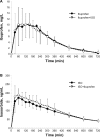Combined isosorbide dinitrate and ibuprofen as a novel therapy for muscular dystrophies: evidence from Phase I studies in healthy volunteers
- PMID: 24851040
- PMCID: PMC4018313
- DOI: 10.2147/DDDT.S58803
Combined isosorbide dinitrate and ibuprofen as a novel therapy for muscular dystrophies: evidence from Phase I studies in healthy volunteers
Abstract
We designed two Phase I studies that assessed healthy volunteers in order to evaluate the safety and to optimize the dosing of the combination of the drugs isosorbide dinitrate, a nitric oxide donor, and ibuprofen, a nonsteroidal antiinflammatory drug. We designed these studies with the aim of designing a Phase II trial to evaluate the drugs' efficacy in patients affected by Duchenne muscular dystrophy. For the first trial, ISOFEN1, a single-dose, randomized-sequence, open-label, active control, three-treatment cross-over study, was aimed at comparing the pharmacokinetics of ibuprofen 200 mg and isosorbide dinitrate 20 mg when given alone and concomitantly. The pharmacokinetics of ibuprofen given alone versus ibuprofen given concomitantly with isosorbide dinitrate were similar, as documented by the lack of statistically significant differences in the main drug's pharmacokinetic parameters (time to maximal concentration [Tmax], maximal concentration [Cmax], area under the curve [AUC]0-t, and AUC0-∞). Similarly, we found that the coadministration of ibuprofen did not significantly affect the pharmacokinetics of isosorbide dinitrate. No issues of safety were detected. The second trial, ISOFEN2, was a single-site, dose titration study that was designed to select the maximum tolerated dose for isosorbide dinitrate when coadministered with ibuprofen. Eighteen out of the 19 enrolled subjects tolerated the treatment well, and they completed the study at the highest dose of isosorbide dinitrate applied (80 mg/day). One subject voluntarily decided to reduce the dose of isosorbide dinitrate from 80 mg to 60 mg. The treatment-related adverse events recorded during the study were, for the large majority, episodes of headache that remitted spontaneously in 0.5-1 hour - a known side effect of isosorbide dinitrate. These studies demonstrate that the combination of isosorbide dinitrate and ibuprofen does not lead to pharmacokinetic interactions between the two drugs; they also demonstrate that the combination of isosorbide dinitrate and ibuprofen has optimal tolerability and safety profiles that are similar to those previously reported for isosorbide dinitrate and ibuprofen given alone.
Keywords: adverse events; coadministration; ibuprofen; isosorbide dinitrate; pharmacokinetic profile.
Figures




Similar articles
-
Nitric oxide donor and non steroidal anti inflammatory drugs as a therapy for muscular dystrophies: evidence from a safety study with pilot efficacy measures in adult dystrophic patients.Pharmacol Res. 2012 Apr;65(4):472-9. doi: 10.1016/j.phrs.2012.01.006. Epub 2012 Jan 25. Pharmacol Res. 2012. PMID: 22306844 Clinical Trial.
-
Pharmacokinetics and tolerability of intravenous ibuprofen injection in healthy Chinese volunteers: a randomized, open-label, single- and multiple-dose study .Int J Clin Pharmacol Ther. 2016 Nov;54(11):904-913. doi: 10.5414/CP202603. Int J Clin Pharmacol Ther. 2016. PMID: 27569737 Clinical Trial.
-
Comparative Bioavailability Study of a New Orodispersible Formulation of Ibuprofen Versus Two Existing Oral Tablet Formulations in Healthy Male and Female Volunteers.Clin Ther. 2019 Aug;41(8):1486-1498. doi: 10.1016/j.clinthera.2019.04.040. Epub 2019 Jun 12. Clin Ther. 2019. PMID: 31202508 Clinical Trial.
-
Combined and alternating paracetamol and ibuprofen therapy for febrile children.Evid Based Child Health. 2014 Sep;9(3):675-729. doi: 10.1002/ebch.1978. Evid Based Child Health. 2014. PMID: 25236309 Review.
-
Serious infectious events and ibuprofen administration in pediatrics: a narrative review in the era of COVID-19 pandemic.Ital J Pediatr. 2021 Jan 29;47(1):20. doi: 10.1186/s13052-021-00974-0. Ital J Pediatr. 2021. PMID: 33514404 Free PMC article. Review.
Cited by
-
Current understanding of molecular pathology and treatment of cardiomyopathy in duchenne muscular dystrophy.Molecules. 2015 May 15;20(5):8823-55. doi: 10.3390/molecules20058823. Molecules. 2015. PMID: 25988613 Free PMC article. Review.
-
Effect of Ibuprofen on Skeletal Muscle of Dysferlin-Null Mice.J Pharmacol Exp Ther. 2018 Mar;364(3):409-419. doi: 10.1124/jpet.117.244244. Epub 2017 Dec 28. J Pharmacol Exp Ther. 2018. PMID: 29284661 Free PMC article.
-
Deficient nitric oxide signalling impairs skeletal muscle growth and performance: involvement of mitochondrial dysregulation.Skelet Muscle. 2014 Dec 12;4(1):22. doi: 10.1186/s13395-014-0022-6. eCollection 2014. Skelet Muscle. 2014. PMID: 25530838 Free PMC article.
-
Evaluation of Ibuprofen Use on the Immune System Indicators and Force in Disabled Paralympic Powerlifters of Different Sport Levels.Healthcare (Basel). 2022 Jul 18;10(7):1331. doi: 10.3390/healthcare10071331. Healthcare (Basel). 2022. PMID: 35885857 Free PMC article.
-
Nitric Oxide Donor Molsidomine Positively Modulates Myogenic Differentiation of Embryonic Endothelial Progenitors.PLoS One. 2016 Oct 19;11(10):e0164893. doi: 10.1371/journal.pone.0164893. eCollection 2016. PLoS One. 2016. PMID: 27760216 Free PMC article.
References
-
- Dubowitz V. Prednisone for Duchenne muscular dystrophy. Lancet Neurol. 2005;4(5):264. - PubMed
-
- Ruegg UT. Pharmacological prospects in the treatment of Duchenne muscular dystrophy. Curr Opin Neurol. 2013;26(5):577–584. - PubMed
-
- Jarmin S, Kymalainen H, Popplewell L, Dickson G. New developments in the use of gene therapy to treat Duchenne muscular dystrophy. Expert Opin Biol Ther. 2014;14(2):209–230. - PubMed
Publication types
MeSH terms
Substances
LinkOut - more resources
Full Text Sources
Other Literature Sources
Medical

